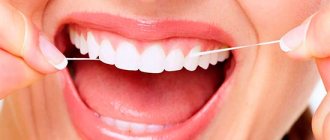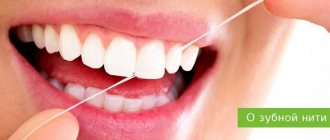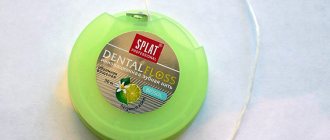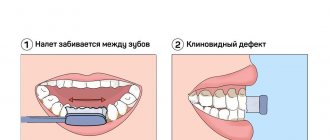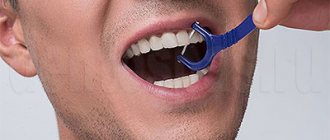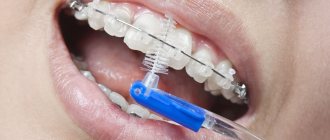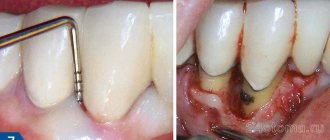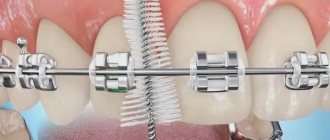- What are dental floss and brush used for?
- How to choose dental floss
- Types of dental floss
- How to floss
- Types of dental brushes
- How to choose a brush
- How to brush your teeth with a brush
- Which brand of dental floss and brushes should I choose?
The tooth has as many as five surfaces, each of which needs regular cleaning. A toothbrush can only clean three sides - the outer, inner and chewing sides. But she cannot reach the interdental spaces, where food debris accumulates and harmful bacteria multiply, which lead to caries. By the way, the total area of such spaces is about 40% of the area of all teeth, and more than half of the cases of caries begin there.
There are several ways to clean the interdental spaces - an irrigator, a brush and dental floss. These are important oral care products and necessary accessories for those who wear braces. You can read more about caring for braces here. We have also already written a lot about irrigators, so in this article we will talk about what brushes and flosses are and how to use them.
What are dental floss and brush used for?
Floss and brush solve a number of problems:
- help remove pieces of food from hard-to-reach places;
- remove soft plaque, preventing the formation of caries, tartar, gingivitis and bad breath.
It would seem that these two items perform the same function, but no.
Each tooth in the mouth does its job. The incisors bite off the food, the fangs tear it into small pieces, the chewing teeth grind it into porridge, so that the food bolus then goes further into the stomach.
Due to the fact that the functions of teeth are different, their shape is also different and the interdental spaces are also different.
The front teeth - incisors and canines - have even spaces. Thread is ideal for cleaning them. We'll talk about the correct cleaning technique below.
The chewing teeth (those located further) have uneven spaces; they may have indentations that are not visible to us. In this case, dental floss will be ineffective because it will only be able to clean the joints of the teeth, but will not reach the grooves.
A thread can't do it, but a brush can. This is because its flexible bristles compress in narrow areas between the teeth, and expand in wide areas. This way no surface will be missed.
Therefore, dental floss is ideal for cleaning the front teeth, and brushes are ideal for cleaning the back teeth.
Types of dental floss
- Made from natural silk - they clean enamel well, but such threads are expensive and fragile, so there is no point in using them.
- Made from nylon, they are as elastic as silk, but are cheaper.
- Acetate is an elastic, durable fiber with a structure similar to silk.
- Made from nylon - they have high strength, but have a rough structure.
- With Teflon coating - they carefully care for teeth, do not injure the gums, and do not separate into fibers. The main feature is that they are flat, like a ribbon and the smoothest. Suitable for the narrowest interdental spaces.
The texture of the thread can be:
- waxed - it is coated with a layer of wax, making it easier to penetrate hard-to-reach places. Suitable for people with a large number of fillings, beginners and children;
- unwaxed - it better removes dietary fiber due to stratification and coverage of most of the tooth.
Thread shapes:
- round;
- flat (tape);
- volumetric (expanding);
- superfloss.
If you just need to clean between your teeth, choose regular floss based on the distance between your teeth. If they are located close to each other, choose tape. If the distance is normal, use a round thread. If it is wide, it is a voluminous floss: under the influence of saliva it swells and fills the entire interdental space. Even if your gaps are of different widths, volume floss will adjust. Also, due to its softness, it is suitable for sensitive gums.
If you are concerned about severe plaque formation, try floss impregnated with chlorhexidine - it has an antibacterial effect. And the thread with zinc and fluoride ions prevents the development of caries.
If you whiten your teeth yourself using pastes or trays, remember that traces of the old tone may remain in the spaces between teeth. In this case, you will need a thread with carbamide peroxide, which saturates the enamel with oxygen and thereby whitens it.
If you have braces, implants, crowns and bridges, your option is superfloss. This is a thread that combines two types of fibers.
- Hard fiber
A rigid tip is made of it, with the help of which the floss easily penetrates narrow spaces in structures, for example, under an arch.
- Sponge fiber
Used to remove plaque from braces, bridges and implants.
Alternating the fibers with each other allows the superfloss to reach places where regular dental floss cannot reach.
Possible contraindications
Floss cannot be used in the following cases:
- Bleeding gums due to periodontal disease. If you use the thread too intensively, it will lead to an inflammatory process.
- Caries. In this case, flossing may cause a piece of the diseased tooth to break off.
- If there are bridges, crowns and other dental structures in the oral cavity, it is better to use only those threads that are recommended by the treating dentist. This is a relative contraindication, and the advisability of using floss in this case is determined by the doctor.
How to floss
There are several cleaning methods. The standard technique is available in many available sources, but it has a significant drawback: if you do not control the sliding of the floss between the teeth, you can seriously injure the gums. In addition, the thread needs to be wound around the index and middle fingers, and this is not very convenient, and it’s just painful.
An alternative is the loop method. This is a simple technique that does not use force, which means the risk of gum damage is minimal. You control the dental floss, and in this position it is convenient to hold it with your fingers.
1. Measure 20-30 cm of thread. To measure the distance, you need to wrap the thread around your fingers, as shown in the figure. If the loop turns out to be large, the thread will be inconvenient to use.
2. Connect the two ends and tie them so that you get a loop that will fit 4 fingers of your right hand and 4 fingers of your left hand at the same time. If you have waxed thread, the knot may come undone, in which case make it a double knot.
3. Place the fingers of both hands in the center of the loop, leaving your thumbs outside the loop. Using your little fingers, create a stop at the bottom of the loop. This will allow you to control the sliding of the thread along the tooth wall.
4. Place the floss between your thumbs so that the distance between them is no more than 5 mm. This will allow you to control the movement of the thread in the interdental space.
5. Move the floss gently up and down along the side of the tooth, starting from the gum.
6. Without removing the floss from the interdental space, transfer it to the adjacent tooth and clean its side surface.
7. Remove the floss from the interdental space. Move your fingers slightly in the loop onto a clean section of thread. Repeat the procedure with the next interdental space.
This technique will allow you to brush your teeth not only effectively, but also safely for your gums. Ideally, you should floss your teeth after every meal, that is, about 3 times a day.
Let us remind you once again that plaque can be effectively removed with floss only between the front teeth. When cleaning the spaces between chewing teeth, floss will do a worse job than a brush.
Rules for using floss
Waxed dental floss glides easier between teeth, has a denser structure, and is less susceptible to delamination. Such threads are very elastic, so when used, the risk of damaging the delicate gum tissue is lower. They are suitable for beginners. Floss is not a replacement for a toothbrush! It should be used after meals, as well as before morning and evening brushing of teeth.
Due to the splitting of the fibers, unwaxed dental floss adheres more firmly to the surface and cleans teeth better. The right thing to do is to floss over each tooth until a characteristic squeak appears. The technique should first be practiced on waxed dental floss.
Fedorova Yana Valentinovna
Dentist-therapist-periodontist, AktivStom clinic
If you select and use dental floss incorrectly, you can injure the gingival papilla, which will lead to bleeding and pain. In this case, the procedure must be suspended for 2-3 days. It is recommended to apply Metrogyl Denta ointment or Asept adhesive gum balm to the damaged area.
How to choose a brush
At first glance, all dental brushes seem the same - small brushes with multi-colored handles. But each of us has different spaces between our teeth, which means it is important to choose your brush size. This is important because if the brush is smaller than your interdental space, it will not be able to completely remove plaque. If it is larger, it may injure the gums, or, most likely, will not pass into the gap.
It is impossible to understand right away how long the bristles you need in a brush. First you will need to take measurements. Today this is possible at home, using a special probe.
The most convenient probe for such purposes is the Curaprox IAP prime probe. This is a small stick that is divided into 5 color zones. Each zone corresponds to the size and length of the brush head and corresponds to the color of the handle of a particular brush from the Curaprox Prime line. The probe can be purchased separately or in a set with several brushes.
The entire measurement procedure will take a few seconds and guarantees 100% accuracy in the selection of hygiene products based on your individual parameters. Usually, brushes are not used between the incisors (remember, there are threads for this), so after purchasing a probe, measure each distance between the chewing teeth. In one place the interdental distance will be greater, in another less. Based on this measurement, mark the sizes of brushes you need.
If you are just going to start using brushes, it is worth purchasing a starter set with different sizes. This, again, is available from Curaprox.
Harm
If dental floss is used incorrectly, it can cause harm. Inaccurate cleaning of the interdental space can injure the gums, resulting in possible infection and inflammation. In addition, flossing too often can deteriorate the protective barriers between your teeth.
We also must not forget that floss is just an aid to hygiene, and it is not advisable to refuse to use a toothbrush in favor of dental floss.
Types of dental brushes
You need to choose brushes based on the shape and length of the bristles. There are two types of brush shapes: cylinder and cone.
- Cylinder
It has the same length of bristles, copes well with food stuck between teeth, prevents periodontitis, and is suitable for implants.
- Cone
The bristles become shorter towards the tip of the brush. Suitable for cleaning braces and dentures, as it allows you to clean areas under the clasps and in the spaces between the crowns.
What length of bristles is needed depends on the size of the spaces between the teeth. If they are narrow, brushes with short bristles (about 1 mm) are suitable. If, on the contrary, you are large or have braces, choose a brush with bristles no shorter than 3 mm.
How to brush your teeth with a brush
The best time to clean between teeth is in the evening. Whether you do this before or after brushing your teeth doesn’t matter.
We consider Curaprox interdental brushes to be one of the best. They are very easy to use, and their manufacturer has proposed their own cleaning method - just like in the case of atraumatic flossing using the loop method.
1. Insert the brush at an angle to the gum.
2. Turn the brush perpendicular to the teeth and carefully move it into the interdental space.
3. You should feel that the brush has come out from the other side.
4. 1 gap = 1 movement of the brush. Do not rotate the brush or move it back and forth.
5. Slowly remove the brush and insert it into the next gap.
What to do if floss gets stuck between teeth?
Such problems are possible if the thread is of poor quality or it was chosen incorrectly - the wrong size. There is no need to pull it out and be nervous; there is also no need to forcefully try to pick it out from the interdental space with a toothpick or other improvised means. You can try to grab the tip with tweezers, and if it doesn’t stick out anywhere, you can remove the floss using another piece; it is advisable to choose a smaller thread.
You cannot forget about a floss stuck between your teeth, because over time, remaining in the interdental space, it can lead to various problems, therefore, if you cannot remove the floss yourself, you need to go to the dentist, who will quickly remove the floss.
Which brand of dental floss and brushes should I choose?
Dental floss and brushes must be durable, not oxidize under the influence of saliva and not cause allergies. We recommend products from Curaprox, Biorepair, Miradent, Pierrot, GUM, ROCS and Splat - all of them meet these requirements.
When making a purchase, you should focus not on the manufacturer, but on the type of dental floss or brush, taking into account the individual characteristics of the structure of the teeth, the presence of orthodontic structures and your dental goals. However, some brands have distinctive features that should be taken into account.
Thus, Prime Start brushes from Curaprox are considered the thinnest on the market. The Cural surgical steel from which the rods are made does not contain nickel and is therefore ideal for allergy sufferers. And the bristles of Biorepair brushes are treated with tiny particles of hydroxyapatite - the building substance that our teeth are made of. By acting on the enamel, microRepair particles restore and strengthen it.
